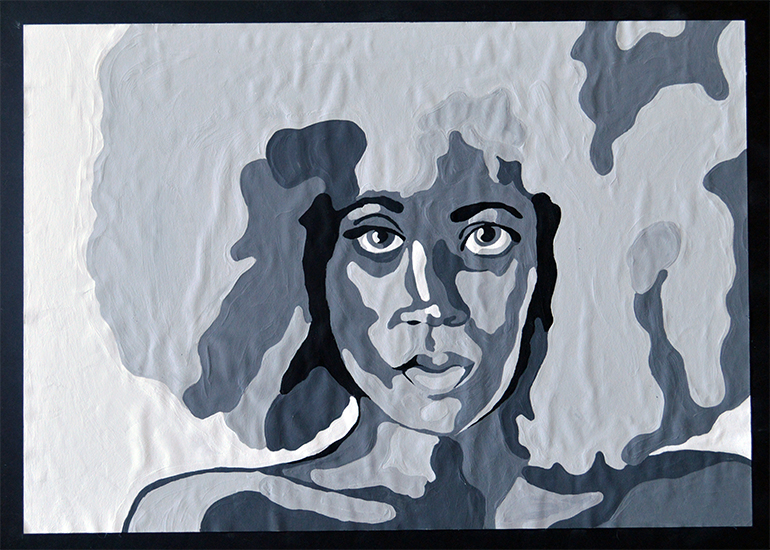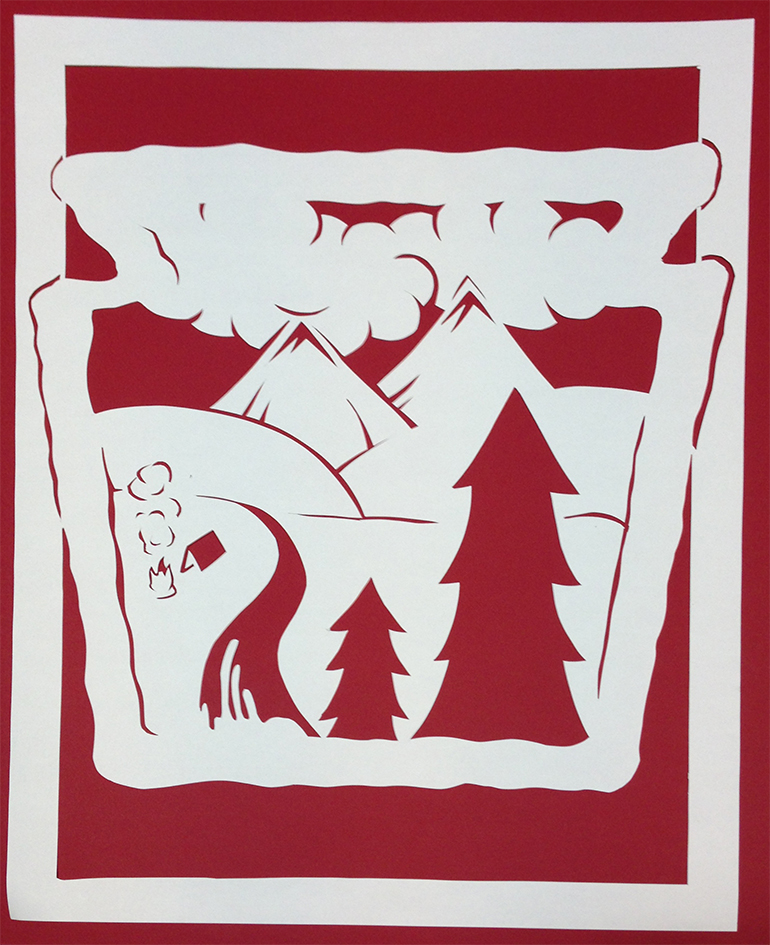


Two Dimensional Design
Introduction to underlying concepts for making and analyzing two-dimensional art. Application of the use of design elements and principles with basic color theory to achieve specific goals for visual communication is studied.
The objective of this class is to introduce the student to the tools, techniques and vocabulary that are essential to the development of understanding twodimensional design. By the end of term, the student will become familiar with the elements and principles of two-dimensional design, explore color theory, and develop a visual literacy through making art that reflects an understanding of craft, composition and content.
- Download the Syllabus
- Project 1
In this project, the student will begin learning the basic elements and principles of two-dimensional design utilizing a limited graphic, or visual vocabulary. The student will cut sheets of black paper into Geometric Shapes and used within a square composition to demonstrate your understanding of Representational vs. Non-representational Shapes, Geometric vs. Organic Shapes, Positive vs. Negative Space, Figure/Ground Reversal, Balance and Craft.
Download Assignment Sheet - Project 2
The student will develop an understanding of the possibilities inherent in Line, Organic/Geometric Shapes, Negative/Positive Space, Figure/Ground Reversal, Representational/Nonrepresentational Shapes and Balance. The student will become more articulate in the craft of cutting paper. The student's understanding of 2D design as applied to the creation of visual effects will become more observant. The student will create a cut paper design. This design can be nonrepresentational or representational and be comprised of organic or geometric shapes, or a combination of all of the above.
Download Assignment Sheet - Project 3
The student will develop an understanding of the possibilities inherent in value, transition, contrast and balance. You will become more articulate in the craft of cutting and gluing paper. The will also be introduced and experiment with painting techniques and gel mediums. Your understanding of 2D design as applied to the creation of visual effects will become more observant. The student will learn how to mix a sequence of nine equally graded values in paint and create a ten-step grayscale study from white to black. This design can be non-representational or representational and be comprised of organic or geometric shapes, or a combination of all of the above. The design will reflect your understanding of Craft, Shape, Balance, Space, Grayscale, and Transition.
Download Assignment Sheet - Project 4
The purpose of this project is to gain an understanding of the use of software applications in the context of 2D design, specifically Photoshop CS6. You will become familiar with a Mac platform, as well as, Photoshop CS6, cropping, pasting, layers, flattening, free transform, transform, adjustments, move tool, and alignment tools. To explore how we often see connections between similar visual elements in art and how this can by utilized to carry the viewers’ eye around the composition (movement) and to create unity. To continue the student's study of Line, Balance, Positive and Negative Space, Shape, Contrast, Value, Unity, and Texture. The student will also be identifying similarities between disparate visual elements and unifying these elements into a harmonious gridded composition using Photoshop CS6.
Download Assignment Sheet - Project 5
The student builds upon the design skills they have already been developing and add the new terms of hue, tone, tint, shade, primary colors, secondary colors, tertiary colors, analogous colors, complementary colors, and split complements. The students will also work to improve craft and gain an understanding of basic paint mixing skills and color theory. Gain an understanding and ability to apply the mechanics of the color wheel to a singular design. For the project the student will create a reimagined version of the color wheel Johannes Itten development for the Bauhaus. The color wheel will feature Primary Colors (red, yellow, blue) then the Secondary Colors (made by mixing two primaries getting orange, green, violet) and Tertiary Colors (made by mixing a primary color with a secondary color getting yellow-orange, yellow-green, red-violet, red-orange, blue-green and blue-violet).
Download Assignment Sheet - Project 6
This assignment will work with the theories of color relativity developed by Josef Albers. The student will also explore the terms analogous, complementary, triadic, split complementary, and tetradic, which all refer to type of color schemes the student can use for this project. For the project, the student will create three identical compositions. The student will then choose one color from the 12 hues the student worked with in the last project to use as his/her main color. The student will then create three different color palettes based off his/her chosen color. The color palettes can be any of the following: analogous, complementary, triadic, split complementary, or tetradic. The main color should be used in the same spot(s) in each composition. The other colors in the student's chosen palettes should be used in the remainder of the design.
Download Assignment Sheet - Project 7
The Final Project will be comprised of an artistic examination (an artwork) that demonstrates the student's understanding/ability to manipulate the fundamental 2D design elements and principles covered in this course. What specific topics have we discussed? These 2D Elements include: Line, Shape, Texture, Value, Color, and Positive/Negative Space. The Principles of 2D design include: Unity/Harmony, Repetition, Rhythm, Balance, Contrast, Transition, Variety. This project will include demonstrations of the student's acquired technical skills in craft, painting, color mixing, cutting, pasting, and assembly. The student's project must include examples of basic color harmonies and applicable variations of pure hues, their tints, shades, tones and intensities. The student must also achieve a unified harmonious design manipulating form and space.
Download Assignment Sheet
